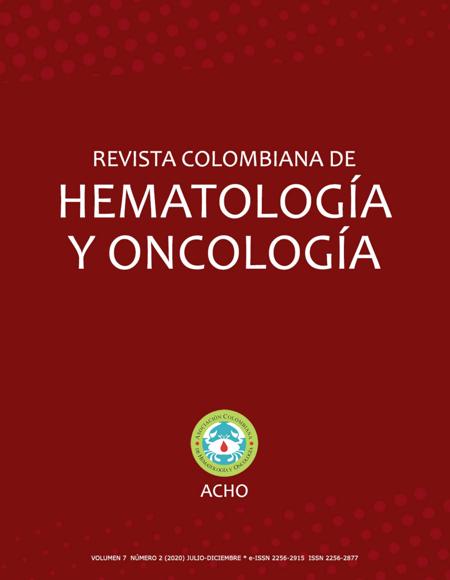Clinicopathological characterization and microbiological findings of febrile neutropenia in oncohematological patients
Caracterización clínico patológica y hallazgos microbiológicos de la neutropenia febril en pacientes oncohematológicos en una clínica privada en la ciudad de Montería-Colombia.

How to Cite
Download Citation

This work is licensed under a Creative Commons Attribution-NonCommercial-NoDerivatives 4.0 International License.
Show authors biography
Background. Febrile neutropenia is a frequent complication in cancer patients receiving chemotherapy. It is estimated that 50% of patients with solid malignancies and more than 80% with hematologic malignancies develop neutropenia and fever at some point in their evolution. Objective: To identify the clinical-pathological characteristics, establish the infectious foci, determine the microbiological profile in oncological patients who present with febrile neutropenia as a post-chemotherapy complication and / or target therapies at the Instituto Medico de Alta Tecnología (IMAT) in the city of Montería - Colombia between June 2014 to June 2016. Material and methods: This is a descriptive study; The study population corresponds to patients over 18 years of age with a diagnosis of hematological malignancy or solid malignant tumor presenting with febrile neutropenia between June 2014 and June 2016, who meet the inclusion criteria. Statistical analysis: the analysis of the information was carried out in software R version 3.5.1). Results: 76 cases of febrile neutropenia were documented. The average age was 43 years and 55% of the patients were male. 84.2% of cases occurred in patients with hematologic malignancies, acute leukemias being the most prevalent. Infectious focus was determined in 68%, respiratory tract infections was the predominant clinical infectious focus (21%). Gram negative bacilli were the most frequently isolated germs. Conclusion: In this series, respiratory tract infections were the predominant infectious focus in patients with febrile neutropenia. Gram negative bacilli, the main responsible microorganisms. The mortality rate related to febrile neutropenia was 14%, results similar to those described in the Colombian population and worldwide.
Article visits 1204 | PDF visits 1839
Downloads
- Gayol M, Font A, Casas I, Estrada O, Domínguez M, Botet P. Utilidad de la escala de MASCC en el tratamiento de neutropenia febril inducida por quimioterapia en pacientes con neoplasia sólida. Med Clin (Barc) [Internet]. 2009; 133 (8): 296-299. https://doi.org/10.1016/j.medcli.2008.12.022
- Freifeld A, Bow E, Sepkowitz K, Boeckh M, Ito J, Mullen C, et al. Clinical Practice Guideline for the Use of Antimicrobial Agent in Neutropenic patients with Cancer: 2010 Update by the Infectious Diseases Society of America. Clinical Infectious Diseases [Internet]. 2011; 52 (4):56-93. https://doi.org/10.1093/cid/cir073
- Klastersky J, Naurois J, Rolston K, Rapoport B, Maschmeyer G, Aapro M, et al. Management of febrile neutropenia: ESMO Clinical Practice Guidelines. Annals of Oncology [Internet]. 2016; 27(Suppl 5): v111-v118. https://doi.org/10.1093/annonc/mdw325
- González X, Gamba J, Bolaños J, Villeta L. Aislamientos microbiológicos en pacientes con neutropenia febril. ¿Es apropiado el uso de las guías clínicas internacionales en México? Rev Hematol Mex. [Internet]. 2013; 14: 113-119. https://bit.ly/3ofXyFf
- Rasmy A, Amal A, Fotih S, Selwi W. Febrile neutropenia in cancer patient: Epidemiology, microbiology, pathophysiology and management. Journal of Cancer Prevention & Current Research [Internet]. 2016;5(3):00165. https://doi.org/10.15406/jcpcr.2016.05.00165
- Klastersky J. Raftopoulos H, Rapoport B. The MASCC Neutropenia, Infection and Myelosuppression Study Group evaluates recent new concepts for the use of granulocyte colony-stimulating factors for the prevention of febrile neutropenia. Support Care Cáncer [Internet]. 2013; 21: 1793-1795. https://doi.org/10.1007/s00520-013-1776-9
- Maldonado S, Bermúdez L, Gómez J, Castillo J, Sánchez R, Ballesteros M, et al. Guía de práctica clínica para el diagnóstico y el tratamiento de las infecciones bacterianas y micóticas en pacientes oncológicos mayores de 15 años con neutropenia febril posquimioterapia de alto riesgo. Rev Colomb Cancerol [Internet]. 2014; 18 (4): 186–196. http://dx.doi.org/10.1016/j.rccan.2014.06.002
- White L, Ybarra M. Neutropenic fever. Emerg Med Clin N Am 2014; 32: 549-561. https://doi.org/10.1016/j.emc.2014.04.002
- Aapro MS, Bohlius J, Cameron DA, Dal Lago L, Donnelly JP, Kearney N, et al. 2010 update of ECRTC guidelines for the use granulocytes-colony stimulating factor to reduce the incidence of chemotherapy-induced febrile neutropenia in adult patients with lymphoproliferative disorders and solid tumours. Eur J Cancer [Internet]. 2011; 47: 8-32. https://doi.org/10.1016/j.ejca.2010.10.013
- García K, Londoño J, Villegas L, González M, Correa A. Diagnóstico microbiológico en neutropenia febril secundaria a quimioterapia por malignidad hematológica. Acta Médica Colombiana [Internet]. 2020; 45:1-7. https://doi.org/10.36104/amc.2020.1386
- Arroyave T, Puerta J, Beltran R, Salgado T, Ramirez D, Arroyave D, et al. Características de los pacientes adultos con neutropenia febril en un hospital universitario (Medellín, 2012-2016). Medicina UPB [Internet]. 2019; 38(2): 108-113. https://doi.org/10.18566/medupb.v38n2.a02
- Cataño D, Marín D, Rivera J, Martínez J, Sánchez J, et al. Neutropenia febril asociada a quimioterapia en pacientes con neoplasias hematológicas de un centro de referencia en Colombia: Características clínicas y desenlaces. SaludUninorte [Internet]. 2020 35(2):205-220. http://dx.doi.org/10.14482/sun.35.2.616.15
- Garzón J, Isaza N, Posada A, Méndez R, Rodríguez M, Ardila MP, et al. Características clínicas y microbiológicas de pacientes con neutropenia febril en un hospital universitario. Infectio [Internet]. 2019; 23(4): 347-357. http://dx.doi.org/10.22354/in.v23i4.806
- Ramos P, Sánchez R, Gamboa O, Cardona A. Factores pronósticos relacionados con la mortalidad en pacientes con cáncer y neutropenia febril. Revista Colombiana de Hematología y Oncología. 2012; 1(4):15-22
- Schelenz S, Giles D, Abdallah S. Epidemiology, management and economic impact of febrile neutropenia in oncology patients receiving routine care at a regional UK cancer centre. Ann of Oncology [Internet]. 2012; 23: 1889-1893. https://doi.org/10.1093/annonc/mdr520
- Punnapuzha S, Edemobi PK, Elmoheen A. 2019 Dec 30. In: StatPearls [Internet]. Treasure Island (FL): StatPearls Publishing; 2020 Jan
- Weycker D, Bensink M, Lonshteyn A, Doroff R, Chandler D. Use of colony stimulating factor primary prophilaxis and incidence of febrile neutropenia from 2010-2016: a longitudinal assesment. Curr Med Res Opin [Internet]. 2019; 35(6): 1073-1080. https://doi.org/10.1080/03007995.2018.1558851

















